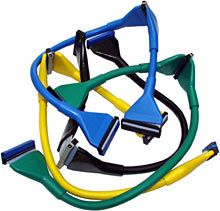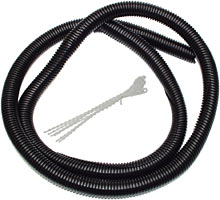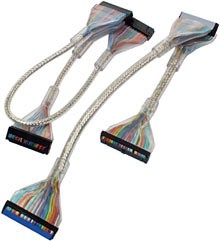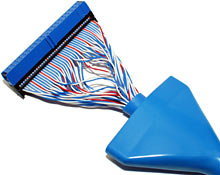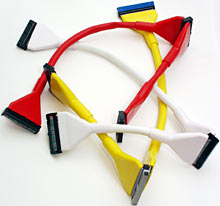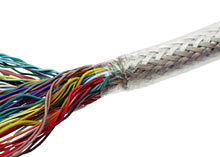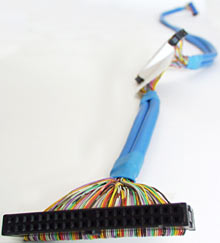
Fancy IDE leads - The Terrible Truth
Review date: 24 August 2001. Last modified 03-Dec-2011.
It would appear, from perusal of numerous authoritative sources, that you ain't got a stylin' computer case if you ain't got nice compact round cables. Plain old ribbon cable is out, out, out, dahlink.
There are reasons, beyond simple self-gratification, for "rounding" cables.
Round cables are easier to route from place to place, for instance. This matters, for stacked PCs with drives all over the darn place. Round cables also make less of a wire-clot to impede air flow through your case. It's possible to elegantly route ribbon cables, and to gather up the excess of too-long cables so that it doesn't make a mess, but most people don't do it. The result is generally a case interior that looks like a lasagna baking accident.
It's not exactly rocket science to round cables yourself. If you foul up and cut a conductor or three, it's not like you've destroyed a million dollar object, after all. But if you'd rather buy pre-made rubber-sleeved groovy-looking ones, you can.
Aus PC Market have been selling rounded cables for a while. Now, though, they've got rubber-tubed SCSI, IDE and floppy cables.
If round cables don't give you all the neatness you want, though, AusPC also now stock...
...this "wire manager" ribbed black plastic tubing, with a 20mm internal diameter and a slit down the side that lets you get your cables into it, and also allows the tubing to expand to hold quite a lot of cables. It's $AU16.50, delivered, for two metres. It comes with a bundle of quality knobby nylon cable ties.
And if you prefer the look of tinned shielding braid to opaque insulation, you can get that too.
The end?
On the face of it, you wouldn't think there'd be a lot to know about these cables. Cables, nifty looking, round. Same as cables, boring grey, flat. Only they're round. And look nicer. Buy, plug in, enjoy. Right?
Wrong. Nothing is easy.
You see, the cheerful-coloured IDE leads in the first picture above are 60 centimetres in length. That's about 23.6 inches.
The maximum cable length you're meant to use for any ATA interface - any kind of modern "IDE" drive - is 457mm, according to the official specification. That's 18 inches.
This length limit applies to 40- and 80-wire cables alike. 80-wire cables also can't be any shorter than 254mm (ten inches), by the way.
The 18 inch limit is why IDE is an internal-drives-only interface. You can run the cable out of your PC's case if you like, but it won't get far.
The spec mandates such short cables for two reasons.
Reason one - practically all IDE cables are unshielded. There's nothing around the conductors but insulation. Electromagnetic radiation goes straight through insulation. So external interference from the rest of your computer's giblets can influence the signal on your IDE leads.
Unshielded cables act like antennas. Generally speaking, the longer you make 'em, the more energy they can pick up from their environment.
Reason two - IDE cables are unterminated. "Termination", in the electrical sense, is essential to provide "impedance matching", which in English is what you have to do to stop the signal from reflecting off the end of the cable like a wave that hits the end of a bathtub.
Electric current does not move instantaneously down a wire. It travels at nearly the speed of light, but when you've got thirty-three and a third million clock pulses per second - which is the speed of the IDE bus - even light in a vacuum only moves a hair under nine metres per clock pulse.
So if you're fooling around with, say, a double-the-rated-length 900mm IDE lead, there's an end-to-end signal delay in it of about a tenth of a clock pulse. The signals you want your drives and your motherboard to be able to hear will be significantly blurred by delayed reflections from each end of the cable.
Transfer your data at twice or three times the UDMA/33 speed - as UDMA/66 and 100 do - and reflected signals get more and more out of step with the real signal, and do it more and more harm.
SCSI works with long unshielded ribbon cables because it puts terminators at either end. IDE doesn't have 'em.
So what's the advantage of ribbon cables? Well, they're really, really cheap for what they can do.
Do you know what 18 inches of 40-way ribbon cable, sans connectors, costs? About two bucks Australian, retail. One dollar US. Much less per unit length if you buy in bulk.
Cramming 33 megabytes per second of bandwidth (well, in theory at least) into two Aussie bucks worth of wire is a fairly remarkable achievement, if you ask me. Getting twice or three times that into not much more expensive 80-wire cable is even more remarkable. It's not surprising that you're asked to comply with a few rules and regulations in return.
The faster the transfer mode your drives use, the more susceptible they'll be to cable problems, all other things being equal. That's why the 80-wire cable standard for UDMA/66 and UDMA/100 exists at all; it makes the cables less error-prone. Each end of an 80-wire IDE cable has only 40 terminals. The extra interleaved wires are all earths, electrically tied together at each end.
The earths are actually something of a blast from the past. Back in the mists of time when ATA was first conceived, it was an eight bit parallel interface with interleaved ground wires. Just like the modern 80-wire cables, only not as many wires.
Not much later, the wires that started out assigned to ground duty got converted into more data wires, to give the interface 16-bit data width with minimum retooling. That played hob with the electrical characteristics of the cables, but at the low speeds of the early PIO ATA modes, it wasn't a tremendously big deal to get acceptable data clarity.
A ribbon cable with interleaved earths has easily characterised impedance - you can put your finger on how much it will resist the passage of alternating current, like a data signal. It's much easier to send an electrical signal from one device to another if the impedance of the devices, and of the connecting cable, is known. It's possible to design a setup that adapts to impedance mismatches, but it's much cheaper and simpler to match the impedance properly. Well, it is if you've got a decent cable design, anyway.
With interleaved earths, each signal wire interacts very little with the signal wires on either side. The electromagnetic and electrostatic fields from the signal wires get eaten by the earths in between them. Remove the earths, and the cable impedance can vary tremendously - apparently, by a factor of two or three - depending on what wires are and aren't energised at what moment.
IDE device designers don't know how the cable's going to be routed - whether it's going to be hanging in the middle of a case away from the chassis metalwork, or tightly clamped to the side of the case, or some mixture of both. This determines the cable's capacitance to earth - since the PC case is earthed - and that also influences impedance.
In brief, if the impedance is lower than the "driver" circuitry that's trying to send a signal expects, then the driver will be unable to deliver enough current at full signal voltage, the signal strength will thus fall, and you're on your way to data loss. Data-signal drivers have much less trouble feeding high impedance loads - but when the impedance of a 40-wire cable rises for whatever reason, the impedance of the drive on the end of it doesn't. That creates an impedance mismatch at the end, which causes signal reflection problems. Ideally, you don't want the impedance of the cable to vary at all. And interleaving earths among the signal wires does a pretty good job of squishing the impedance fluctuations.
So what happens when you take an 80-wire interleaved-earth ribbon cable, split it into individual wires, and bundle 'em up?
Look under the rubber boot on one of these things and the wires are bundled in neatly enough, but the mixture of data and earth wires is all higgledy-piggledy. If you want to reduce the nasty gang-of-wires effects that happen when particularly inopportune combinations of wires are energised and not energised then mixing the wires up all over the place may well help. If you want a tightly characterised cable, though, I can't help but think that explosion-in-a-spaghetti-factory wiring like this is not going to give you one.
How come they work, then?
What may be causing you a certain amount of confusion at this juncture is the fact that there are people all over the world successfully using over-length ATA cables. Including round ones. Some people use cables 750mm or even 900mm in length, without causing any obvious explosions or outbreaks of smallpox. How so, I hear you ask.
Again, two reasons.
Reason one - good enough components at each end of the cable can deal with more signal corruption than the IDE specification demands of them. Modern ATA hardware is pretty darn good at dealing with lousy cables. Older drives typically have lower tolerances, and some older motherboard IDE chipsets did brilliant things like effectively connecting the two IDE connectors together, as far as length-related problems went. This resulted in seven-inch real-world cable length limits, if you attached cables to both connectors.
But those days are largely past. Current consumer IDE hardware can shout through the noise quite well.
Reason two - IDE covers up data loss problems. The ATA interface has CRC error checking built in. When data's munged in transit down the cable, the error is detected and the data is resent.
Well, it usually is.
CRC will always catch a one-bit error in a given data block. But if more than one bit's wrong, the CRC data may end up the same as it'd be if everything were fine.
That's not at all likely to happen to any given block of data, but in a system with a serious data corruption problem it certainly can happen rather often. Hard drives move a lot of blocks per day.
If data errors get through, you'd better hope there's something working at a higher level than the hardware CRC to catch the error. If nothing does, then the dud data gets written to the hard drive or to your memory. Which will give you corrupt data on the drive and/or a crash, depending on which way the data block was going and what it was for.
Even if no errors that actually get past the checking process, you still don't want a high error rate, because it slows down your drives. CRC only provides error detection, not error correction; to get the correct version of data, blocks with errors have to be sent again.
This means that long or just plain lousy cables may give you better drive performance if you lock the appropriate IDE channel to a slower transfer mode in your computer's BIOS setup. The theoretical available bandwidth is then lower, but if the error rate drops from "tons" to "not many" because you've now got the system running below the IDE cable's threshold of crumminess (a technical term), the net result can be better drive speed.
Want more ways to make things go wrong? Here's one. If you're overclocking your PCI bus - as many motherboards do, if you ask for a higher than normal processor Front Side Bus speed - then you're overclocking your IDE bus as well.
Overclocking the IDE bus is fine as long as it doesn't cause any more errors, but if your cable's borderline already - as it will be if it's greatly over-length - then clocking the bus a bit higher may be just enough to tip the system into real harmful errors.
What are such errors going to do to you, exactly?
Glad you asked.
Bit rot
If you've got a major IDE data loss problem, things will be obviously broken. Drives won't be recognised consistently (or at all) on boot, every file operation of any significant size will cause errors, swap file activity will hang the computer.
That's not the kind of problem you're likely to have from a common-or-garden over-length cable, though. When bits only fall on the floor relatively occasionally, the drives will not obviously be the culprit. If the hardware error detection's catching almost all of the foul-ups, all you'll see is strangely slow drive performance. Since drive speed has little impact on most desktop computer tasks, you probably won't notice.
The most heavily accessed part of your drive is very probably going to be the part that holds your Windows swap file. Since the swap file is literally part of your computer's random access memory as far as Windows is concerned, IDE data integrity problems can cause the same sorts of symptoms as faulty RAM.
Many of these symptoms don't look like drive errors at all. Swap file errors won't give you a disk error warning message; your computer will just jam its head enthusiastically up its cloaca and start chewing like mad. If you don't suspect the drive cable, you will then get to spend a significant fraction of your life cursing at the thing and swapping out perfectly OK components, to no avail.
A computer in this state can give the user the "anti-Midas touch" - everything you touch can turn to dung. Any write operation may, or may not, result in small but file-killing errors.
Oh, yes - what's the second-most-accessed single chunk of disk space on a Windows box? Probably the registry, baby. You don't want errors there, either.
Should you use them?
In practice, 24 inch/600mm cables should be just fine for UDMA/33 mode with modern hardware. They may work OK for UDMA/66 as well, but I wouldn't count on it. "OK", here, seems likely to mean "a fairly high CRC error rate bubbling along where you can't see it", and the result of that may if you're lucky not be any more real problems than you'd see if you used a special super-high-grade IDE cable (like the ones made by Ultracable, for instance).
If you decide to use these things to replace some plain 18 inch ribbon cables, don't throw the old cables away. If your computer goes flaky, try the old cables again before you start hunting bugs elsewhere.
And if your new ultra-turbo UDMA/100 drive doesn't give the performance you expect - even in the fantasy-numbers raw-transfer-rate benchmark of your choice - try it with a ten inch two connector 80-wire ribbon cable and see if anything changes.
If you're planning to put two drives on a cable and work 'em hard in UDMA/100 mode, then I wouldn't do it with any 600mm cable, if I were you.
For this reason, Aus PC Market now provide a selection of cables, including plenty of...
...these. These cables are the same thing, but shorter. They're available in a variety of colours, they're decently priced, and they're 18 inches long.
Actually, if you stretch them out, the total cable length from one end connector to the other works out at about 48 centimetres, which is 18.9 inches - but only in the most marginal situations should this make a difference. Many other "18 inch" leads are a little bit long, as well.
Eagle-eyed readers may note that only one of the cables in the above picture - the yellow one - is actually an IDE lead. The other two are floppy cables, which can be a lot longer than 18 inches and still work. But if your case doesn't have a floppy drive far enough away from the motherboard connector that you need a longer cable, you might as well get the short one for neatness.
The 48cm IDE leads come in blue, black, red, white and yellow; the floppy leads come in all of those colours except for black. A pair of the IDE leads costs $AU38.50, delivered; the floppy leads cost only $13.20 delivered. Aus PC also have bundle packs with two IDE leads and one floppy lead, for $AU49.50 delivered. You can find them all in the Accessories -> Data Cables section of the Aus PC site, which Australian buyers can visit by clicking here.
And then there's these ones. Clear insulation, braided shield around the wires, available in 80-wire IDE and 34-wire floppy versions. They look nifty, and they ought to provide at least some noise isolation as well, which unshielded IDE leads don't.
The boots over the end of the cable are clear, too. Highly decorative.
The braid's connected to most, if not all, of the interleaved earths at each end.
The 48cm versions of these cables sell from Aus PC Market for $AU42.90, delivered, for a pack of two. 48cm and 60cm floppy drive cables to match are $AU14.30 and $AU16.50, respectively, again including delivery. If you want 'em all together - two IDE, one floppy, all 48cm - you'll pay a bit less - only $AU55 delivered.
And then, there's this. It's an 80-wire cable, it's got a peculiar figure-eight cable cross-section of whose benefits I am uncertain, and it's a mighty one metre in length.
That's almost 2.2 times the 18 inch limit, and it's more than twice the length of the near-enough 48 centimetre cables. So if you think you're going to use this thing for UDMA/66 or 100, you've got another think coming, if you know what's good for you. Even for UDMA/33, I wouldn't be too confident about using this cable for a pair of hard drives, or even for one.
That's not what it's for, though. It's meant to let you connect one or two IDE CD-ROM or DVD-ROM drives that're lurking at the top of a tall tower case to a motherboard connector towards the bottom of the case. If you've got drive bays that you can't use because of such a problem, then $AU25.30 delivered for this nice-looking cable ($AU48.40 for a pair) isn't outrageous. If you get errors, though, tough. Use SCSI instead.
Overall
With in-spec 18 inch IDE leads, you may have a really hard time actually connecting all of the drives in a stacked tower case. From the back of the topmost drive bay in your average tower case to the usual motherboard IDE connector location is generally only about 14 inches, as the crow flies. But try to run a cable that far and the twists and turns it's going to have to take will leave you very little slack. You're not likely to be able to connect two drives to the thing.
All you're probably going to be putting in the top drive bays are 5.25 inch CD-ROM or DVD-ROM devices, though. You can use longer cables for them, since UDMA/33 is plenty of speed for even a pair of the fastest such drives currently available. A metre is definitely pushing your luck, though.
If you want a horde of IDE hard drives and can't abide the idea of running them in UDMA/33 mode, it could be an idea to get a more compact case that still has a lot of bays in it. Like the good old Lian Li PC-60 (reviewed here), for instance.
And, of course, there's always SCSI. Even the most restrictive SCSI flavours give you 1.5 metres of cable length to play with and allow at least seven drives per cable. SCSI drives typically have higher quality mechanisms than IDE ones, and can be had with very high rotational speeds that give them blinding performance (and mean they need active cooling, too).
SCSI's extra performance matters not at all for desktop computer purposes and its extra reliability isn't a big deal either, but both are a major consideration for many Serious Storage applications.
You'd blooming well want SCSI drives to be better for the money they cost, of course. Two to four times the dollars per megabyte of the IDE competition. But if you use SCSI and cables tailored to the right length for your setup, you shouldn't have data corruption or cable routing problems.
Anybody somewhat handy can make SCSI or IDE cables of any length, using cheap IDC (Insulation Displacement Connector) plugs and standard ribbon cable, which you can buy from any half-decent electronics store. There are special tools for clamping IDC plugs onto ribbon cable, but you can do it well enough with a bench vise.
Getting back to the main point, though - if you've been considering IDE leads significantly longer than 18 inches for UDMA/66 or faster transfer modes, I suggest you think of a different solution. Windows boxes will crash often enough without help from you.
Buy 'em!
Aus PC Market's got all sorts of rounded cables, and their prices includ Australian
delivery. Readers from Australia or New Zealand can order them from
the Aus PC site.
They're in the Accessories -> Data Cables section.
(if you're NOT from Australia or New Zealand, don't bother going
there!)
